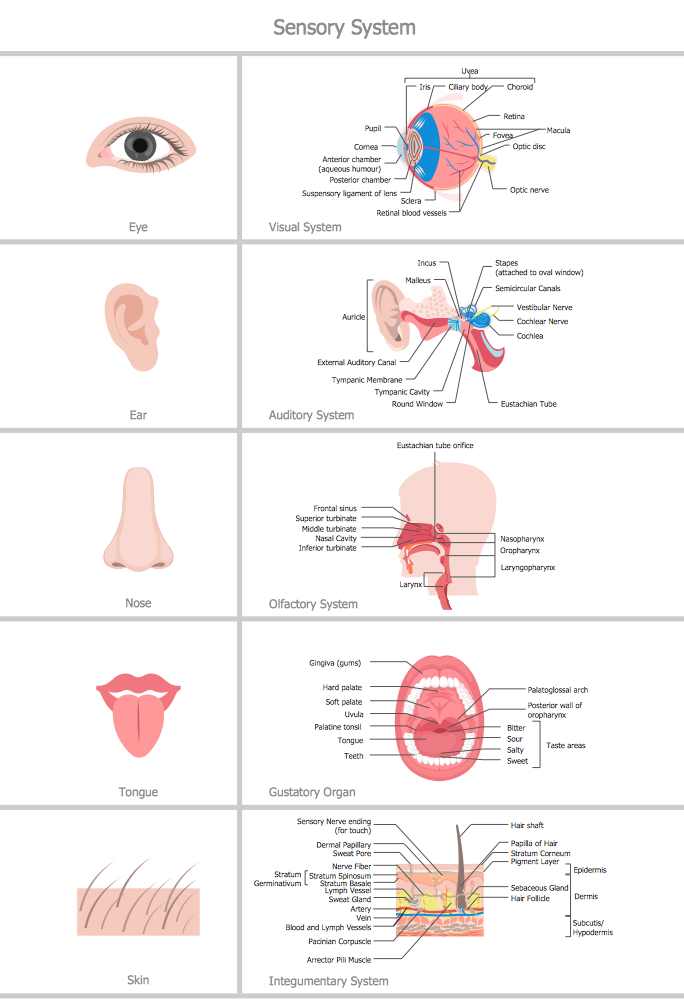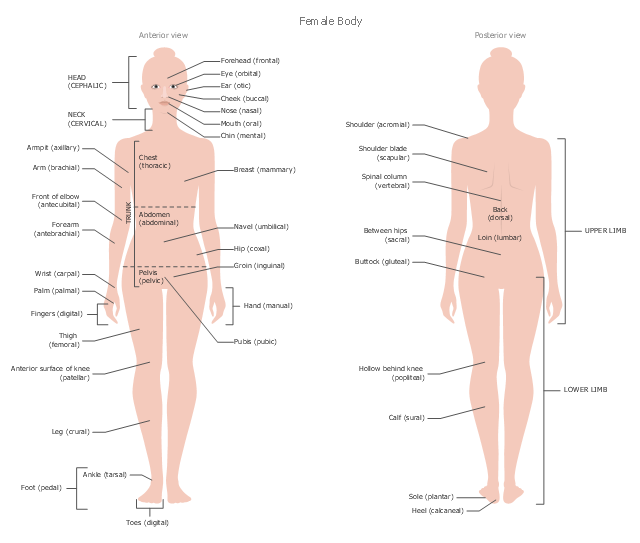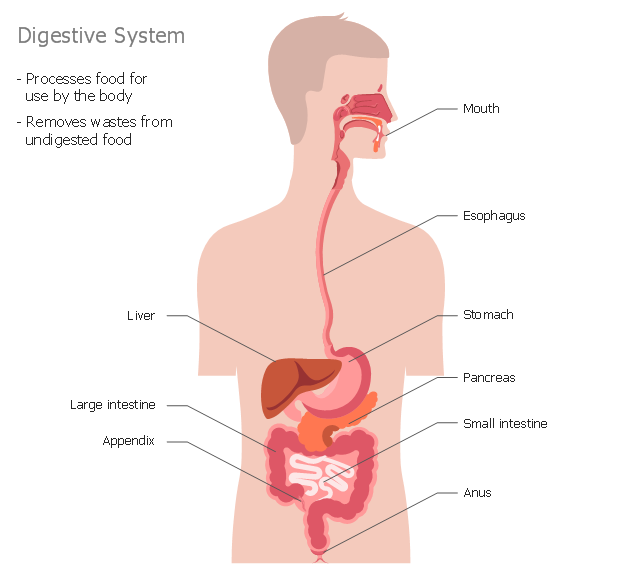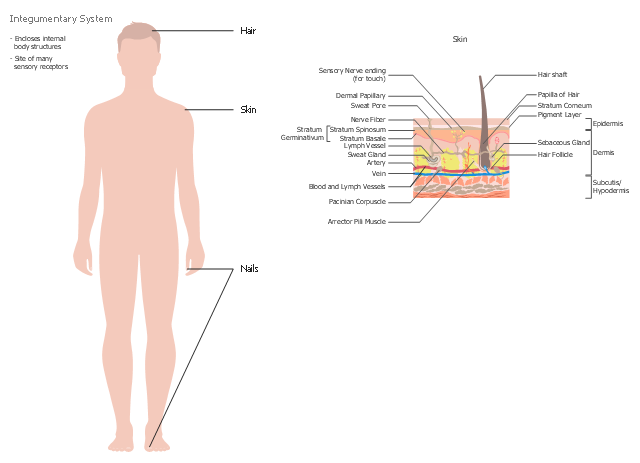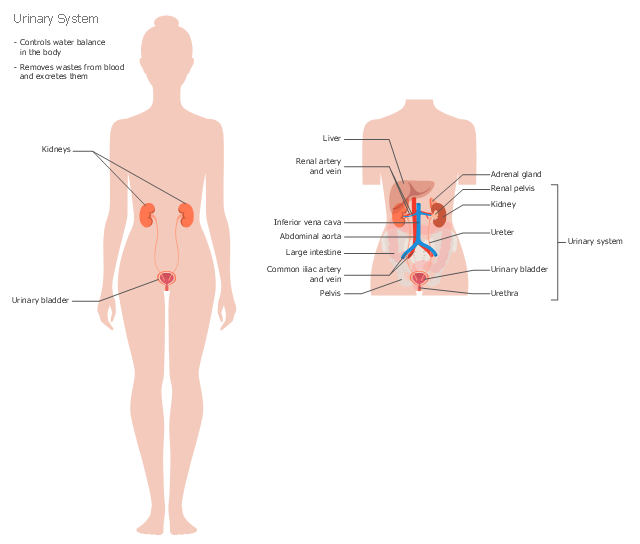 Human Anatomy
Human Anatomy
Human Anatomy solution extends ConceptDraw PRO functionality with best tools to design diagrams and illustrations for using in a sphere of medicine and health care, infographics on the human physiology and anatomy thematic, to represent the structure of male and female bodies from the front and back views, description in details any of physiological systems of the human organism, such as central and peripheral nervous systems, respiratory system, cardiovascular system, digestive system, endocrine system, reproductive system, urinary system, skeletal system, muscular system, integumentary system, lymphatic system, sensory system, visual system, immune system.
The vector stencils library "Human body" contains 25 body part icons.
Use it to design your human anatomy, biological, healthcare and medical illustrations, infographics, diagrams and presentation slides with ConceptDraw PRO software.
"The human body is the entire structure of a human being. It is composed of many different types of cells that together create tissues and subsequently organ systems. They ensure homeostasis and the viability of the human body.
It comprises a head, neck, trunk (which includes the thorax and abdomen), arms and hands, legs and feet." [Human body. Wikipedia]
The body part icons example "Design elements - Human body" is included in Human Anatomy solution from Health area of ConceptDraw Solution Park.
Use it to design your human anatomy, biological, healthcare and medical illustrations, infographics, diagrams and presentation slides with ConceptDraw PRO software.
"The human body is the entire structure of a human being. It is composed of many different types of cells that together create tissues and subsequently organ systems. They ensure homeostasis and the viability of the human body.
It comprises a head, neck, trunk (which includes the thorax and abdomen), arms and hands, legs and feet." [Human body. Wikipedia]
The body part icons example "Design elements - Human body" is included in Human Anatomy solution from Health area of ConceptDraw Solution Park.
HelpDesk
How to Make Medical Illustrations
ConceptDraw Human Anatomy solution is a tool for designing diagrams and illustrations for using in medicine and health care. The huge collection of vector objects covers all needs according to the presentation the structure of male and female bodies from the front and back views, description in details any of physiological systems of the human organism.You can easily create variety of healthcare related visualizations: diagrams, infographics, illustrations etc. The set of ready-to-use samples can be helpful for making slides for presentations and slide-shows, infographics on the human physiology and anatomy thematic.
This human anatomy illustration sample depicts female body parts.
"Female figures are typically narrower at the waist than at the bust and hips. The bust, waist, and hips are called inflection points, and the ratios of their circumferences are used to define basic body shapes. ...
Estrogens have a significant impact on a female's body shape. They are produced in both men and women, but their levels are significantly higher in women, especially in those of reproductive age. ... estrogens promote the development of female secondary sexual characteristics, such as breasts and hips. ...
Estrogens can also affect the female body shape in a number of other ways, including increasing fat stores, accelerating metabolism, reducing muscle mass, and increasing bone formation.
Estrogens cause higher levels of fat to be stored in a female body than in a male body. They also affect body fat distribution, causing fat to be stored in the buttocks, thighs, and hips in women, but generally not around their waists, which will remain about the same size as they were before puberty." [Female body shape. Wikipedia]
The human anatomy illustration example "Female body" was created using ConceptDraw PRO software extended with Human Anatomy solution from Health area of ConceptDraw Solution Park.
"Female figures are typically narrower at the waist than at the bust and hips. The bust, waist, and hips are called inflection points, and the ratios of their circumferences are used to define basic body shapes. ...
Estrogens have a significant impact on a female's body shape. They are produced in both men and women, but their levels are significantly higher in women, especially in those of reproductive age. ... estrogens promote the development of female secondary sexual characteristics, such as breasts and hips. ...
Estrogens can also affect the female body shape in a number of other ways, including increasing fat stores, accelerating metabolism, reducing muscle mass, and increasing bone formation.
Estrogens cause higher levels of fat to be stored in a female body than in a male body. They also affect body fat distribution, causing fat to be stored in the buttocks, thighs, and hips in women, but generally not around their waists, which will remain about the same size as they were before puberty." [Female body shape. Wikipedia]
The human anatomy illustration example "Female body" was created using ConceptDraw PRO software extended with Human Anatomy solution from Health area of ConceptDraw Solution Park.
This human anatomy illustration sample was designed on the base of Wikimedia Commons file: Organ Systems I.jpg [en.wikipedia.org/ wiki/ File:Organ_ Systems_ I.jpg].
This file is licensed under the Creative Commons Attribution 3.0 Unported license. [creativecommons.org/ licenses/ by/ 3.0/ deed.en]
"Skeletal system: structural support and protection with bones, cartilage, ligaments and tendons." [Biological system. Wikipedia]
"The human skeleton is the internal framework of the body. It is composed of around 270 bones at birth – this total decreases to around 206 bones by adulthood after some bones have fused together. ... The human skeleton can be divided into the axial skeleton and the appendicular skeleton. The axial skeleton is formed by the vertebral column, the rib cage, the skull and other associated bones. The appendicular skeleton, which is attached to the axial skeleton, is formed by the shoulder girdle, the pelvic girdle and the bones of the upper and lower limbs.
The human skeleton performs six major functions; support, movement, protection, production of blood cells, storage of minerals, and endocrine regulation." [Human skeleton. Wikipedia]
The human anatomy illustration example "Skeletal system" was created using ConceptDraw PRO software extended with Human Anatomy solution from Health area of ConceptDraw Solution Park.
This file is licensed under the Creative Commons Attribution 3.0 Unported license. [creativecommons.org/ licenses/ by/ 3.0/ deed.en]
"Skeletal system: structural support and protection with bones, cartilage, ligaments and tendons." [Biological system. Wikipedia]
"The human skeleton is the internal framework of the body. It is composed of around 270 bones at birth – this total decreases to around 206 bones by adulthood after some bones have fused together. ... The human skeleton can be divided into the axial skeleton and the appendicular skeleton. The axial skeleton is formed by the vertebral column, the rib cage, the skull and other associated bones. The appendicular skeleton, which is attached to the axial skeleton, is formed by the shoulder girdle, the pelvic girdle and the bones of the upper and lower limbs.
The human skeleton performs six major functions; support, movement, protection, production of blood cells, storage of minerals, and endocrine regulation." [Human skeleton. Wikipedia]
The human anatomy illustration example "Skeletal system" was created using ConceptDraw PRO software extended with Human Anatomy solution from Health area of ConceptDraw Solution Park.
This human anatomy illustration sample was designed on the base of Wikimedia Commons file: Adult Digestive System.png.
[commons.wikimedia.org/ wiki/ File:Adult_ Digestive_ System.png]
This file is licensed under the Creative Commons Attribution-Share Alike 4.0 International license. [creativecommons.org/ licenses/ by-sa/ 4.0/ deed.en]
"The human digestive system consists of the gastrointestinal tract plus the accessory organs of digestion (the tongue, salivary glands, pancreas, liver, and gallbladder). In this system, the process of digestion has many stages, the first of which starts in the mouth. Digestion involves the breakdown of food into smaller and smaller components, until they can be absorbed and assimilated into the body." [Human digestive system. Wikipedia]
The human anatomy illustration example "Digestive system" was created using ConceptDraw PRO software extended with Human Anatomy solution from Health area of ConceptDraw Solution Park.
[commons.wikimedia.org/ wiki/ File:Adult_ Digestive_ System.png]
This file is licensed under the Creative Commons Attribution-Share Alike 4.0 International license. [creativecommons.org/ licenses/ by-sa/ 4.0/ deed.en]
"The human digestive system consists of the gastrointestinal tract plus the accessory organs of digestion (the tongue, salivary glands, pancreas, liver, and gallbladder). In this system, the process of digestion has many stages, the first of which starts in the mouth. Digestion involves the breakdown of food into smaller and smaller components, until they can be absorbed and assimilated into the body." [Human digestive system. Wikipedia]
The human anatomy illustration example "Digestive system" was created using ConceptDraw PRO software extended with Human Anatomy solution from Health area of ConceptDraw Solution Park.
This human anatomy illustration sample was designed on the base of Wikimedia Commons files: Organ Systems I.jpg [commons.wikimedia.org/ wiki/ File:Organ_ Systems_ I.jpg], and Skin.svg [commons.wikimedia.org/ wiki/ File:Skin.svg].
This file is licensed under the Creative Commons Attribution 3.0 Unported license. [creativecommons.org/ licenses/ by/ 3.0/ deed.en]
"The integumentary system is the organ system that protects the body from various kinds of damage, such as loss of water or abrasion from outside. The system comprises the skin and its appendages (including hair, scales, feathers, hooves, and nails). The integumentary system has a variety of functions; it may serve to waterproof, cushion, and protect the deeper tissues, excrete wastes, and regulate temperature, and is the attachment site for sensory receptors to detect pain, sensation, pressure, and temperature." [Integumentary system. Wikipedia]
The human anatomy illustration example "Integumentary system" was created using ConceptDraw PRO software extended with Human Anatomy solution from Health area of ConceptDraw Solution Park.
This file is licensed under the Creative Commons Attribution 3.0 Unported license. [creativecommons.org/ licenses/ by/ 3.0/ deed.en]
"The integumentary system is the organ system that protects the body from various kinds of damage, such as loss of water or abrasion from outside. The system comprises the skin and its appendages (including hair, scales, feathers, hooves, and nails). The integumentary system has a variety of functions; it may serve to waterproof, cushion, and protect the deeper tissues, excrete wastes, and regulate temperature, and is the attachment site for sensory receptors to detect pain, sensation, pressure, and temperature." [Integumentary system. Wikipedia]
The human anatomy illustration example "Integumentary system" was created using ConceptDraw PRO software extended with Human Anatomy solution from Health area of ConceptDraw Solution Park.
This human anatomy illustration sample depicts urinary system.
"The urinary system, also known as the renal system, consists of the kidneys, ureters, bladder, and the urethra. Each kidney consists of millions of functional units called nephrons. The purpose of the renal system is to eliminate wastes from the body, regulate blood volume and blood pressure, control levels of electrolytes and metabolites, and regulate blood pH. The kidneys have an extensive blood supply via the renal arteries which leave the kidneys via the renal vein. Following filtration of blood and further processing, wastes (in the form of urine) exit the kidney via the ureters, tubes made of smooth muscle fibers that propel urine towards the urinary bladder, where it is stored and subsequently expelled from the body by urination (voiding). The female and male urinary system are very similar, differing only in the length of the urethra." [Urinary system. Wikipedia]
The human anatomy illustration example "Urinary system" was created using ConceptDraw PRO software extended with Human Anatomy solution from Health area of ConceptDraw Solution Park.
"The urinary system, also known as the renal system, consists of the kidneys, ureters, bladder, and the urethra. Each kidney consists of millions of functional units called nephrons. The purpose of the renal system is to eliminate wastes from the body, regulate blood volume and blood pressure, control levels of electrolytes and metabolites, and regulate blood pH. The kidneys have an extensive blood supply via the renal arteries which leave the kidneys via the renal vein. Following filtration of blood and further processing, wastes (in the form of urine) exit the kidney via the ureters, tubes made of smooth muscle fibers that propel urine towards the urinary bladder, where it is stored and subsequently expelled from the body by urination (voiding). The female and male urinary system are very similar, differing only in the length of the urethra." [Urinary system. Wikipedia]
The human anatomy illustration example "Urinary system" was created using ConceptDraw PRO software extended with Human Anatomy solution from Health area of ConceptDraw Solution Park.
- Human Anatomy | Apparatus In An Organic Chemistry Lab And Their ...
- Human Anatomy | Digestive System In Flow Chart
- Human Anatomy | Concept Maps | Flow Chart Of Human Endocrine ...
- Human Anatomy | Fishbone Diagrams | Website Wireframe | Human ...
- Human Anatomy | Entity Relationship Diagram - ERD - Software for ...
- Human Anatomy | Fishbone Diagram Problem Solving | Sport ...
- Human Anatomy | Reproductive System In Flow Chart
- Human Anatomy | Apparatus List In Physics
- Human Anatomy | Bar Chart For Representing Ph Value
